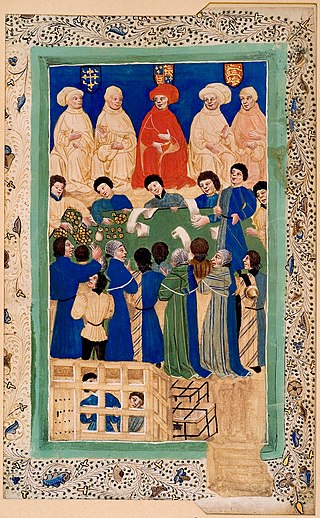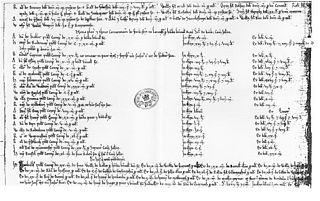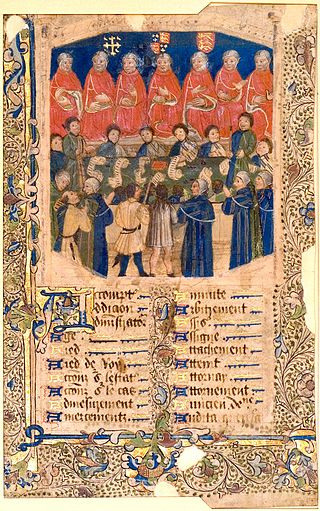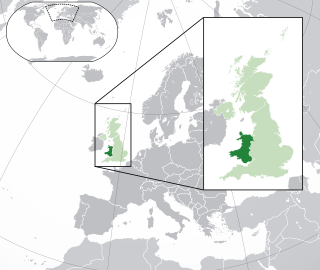Related Research Articles
Tallage or talliage may have signified at first any tax, but became in England and France a land use or land tenure tax. Later in England it was further limited to assessments by the crown upon cities, boroughs, and royal domains. In effect, tallage was a land tax.

In the civil service of the United Kingdom, His Majesty’s Exchequer, or just the Exchequer, is the accounting process of central government and the government's current account in the Consolidated Fund. It can be found used in various financial documents including the latest departmental and agency annual accounts.
The Charter of Liberties, also called the Coronation Charter, or Statutes of the Realm, was a written proclamation by Henry I of England, issued upon his accession to the throne in 1100. It sought to bind the King to certain laws regarding the treatment of nobles, church officials, and individuals. The nineteenth-century historians Frederick Maitland and Frederick Pollock considered it a landmark document in English legal history and a forerunner of Magna Carta.

The history of the Jews in England goes back to the reign of William the Conqueror. Although it is likely that there had been some Jewish presence in the Roman period, there is no definitive evidence, and no reason to suppose that there was any community during Anglo-Saxon times. The first written record of Jewish settlement in England dates from 1070. The Jewish settlement continued until King Edward I's Edict of Expulsion in 1290.

The Exchequer of Pleas, or Court of Exchequer, was a court that dealt with matters of equity, a set of legal principles based on natural law and common law in England and Wales. Originally part of the curia regis, or King's Council, the Exchequer of Pleas split from the curia in the 1190s to sit as an independent central court. The Court of Chancery's reputation for tardiness and expense resulted in much of its business transferring to the Exchequer. The Exchequer and Chancery, with similar jurisdictions, drew closer together over the years until an argument was made during the 19th century that having two seemingly identical courts was unnecessary. As a result, the Exchequer lost its equity jurisdiction. With the Judicature Acts, the Exchequer was formally dissolved as a judicial body by an Order in Council on 16 December 1880.
The Edict of Expulsion was a royal decree issued by Edward I of England on 18 July 1290 expelling all Jews from the Kingdom of England. Edward told the sheriffs of all counties he wanted all Jews expelled by no later than All Saints' Day that year. The expulsion edict remained in force for the rest of the Middle Ages. The edict was not an isolated incident, but the culmination of over 200 years of increasing antisemitism in England. The edict was eventually overturned more than 350 years later, during the Protectorate when Oliver Cromwell permitted the resettlement of the Jews in England in 1657.
It is believed that the first Jews in England arrived during the Norman Conquest of the country by William the Conqueror in 1066. The first written record of Jewish settlement in England dates from 1070. They suffered massacres in 1189–90. In 1290, all Jews were expelled from England by the Edict of Expulsion.
The Saladin tithe, or the Aid of 1188, was a tax, or more specifically a tallage, levied in England and to some extent in France in 1188, in response to the capture of Jerusalem by Saladin in 1187.

The Pipe rolls, sometimes called the Great rolls or the Great Rolls of the Pipe, are a collection of financial records maintained by the English Exchequer, or Treasury, and its successors. The earliest date from the 12th century, and the series extends, mostly complete, from then until 1833. They form the oldest continuous series of records concerning English governance kept by the English, British and United Kingdom governments, covering a span of about 700 years. The early medieval ones are especially useful for historical study, as they are some of the earliest financial records available from the Middle Ages. A similar set of records was developed for Normandy, which was ruled by the English kings from 1066 to 1205, but the Norman Pipe rolls have not survived in a continuous series like the English.
The Statute of the Jewry was a statute issued by Edward I of England in 1275. It placed a number of restrictions on Jews of England, most notably outlawing the practice of usury.
Elias of London also known as Elijah ben Moses or Elias le Evesque, was Presbyter Judaeorum in 13th-century England.

The Court of Common Pleas, or Common Bench, was a common law court in the English legal system that covered "common pleas"; actions between subject and subject, which did not concern the king. Created in the late 12th to early 13th century after splitting from the Exchequer of Pleas, the Common Pleas served as one of the central English courts for around 600 years. Authorised by Magna Carta to sit in a fixed location, the Common Pleas sat in Westminster Hall for its entire existence, joined by the Exchequer of Pleas and Court of King's Bench.

The history of the Jews in Wales begins in the 13th century. However, shortly after the English conquest of Wales, Edward I issued the 1290 Edict of Expulsion expelling the Jews from England. From then until the formal return of the Jews to England in 1655, there is only one mention of Jews on Welsh soil.
Adam de Stratton was a royal moneylender, administrator and clergyman under Edward I of England. He advanced professionally through the patronage of the earls of Devon, and became Chamberlain of the Exchequer and steward of Isabella, Countess of Devon. At the same time he made himself an enormous fortune through moneylending, primarily by acquiring debts from Jewish moneylenders. His business methods were dubious and often involved various illegal activities. In 1290 he fell victim to an investigation of corruption in the royal administration, and from 1292 until his death— no later than 1294—he was held in prison. Stratton has been called by a modern historian "the greatest and probably the most unscrupulous of thirteenth-century money lenders, who eventually met the fate he deserved."

During the Middle Ages there was a small Jewish community in Worcester, a city and county town of Worcestershire in the West Midlands of England that mainly provided money lending services to the non-Jewish citizens. Worcester also hosted a national gathering of England's leading Jews in 1241, to allow the Crown to assess their worth for taxation. The Worcester Bishopric was hostile to the Jewish community in Worcester, commissioning tracts against Jewry, and pushing for segregation of Jews and Christians. During the Second Barons' War, Jews suffered violence and many died in 1255, at the hands of Simon de Montfort's supporters.
William Devereux, Baron Devereux of Lyonshall was an English noble who was an important Marcher Lord as he held Lyonshall Castle controlling a strategically vital approach to the border of Wales in the time of Edward I and Edward II. He was the first of this family officially called to Parliament, and was ancestor to John Devereux, 1st Baron Devereux of Whitchurch Maund, the Devereux Earls of Essex, and the Devereux Viscounts of Hereford. His coat of arms was the same as his father's and described as "argent, fess and three roundels in chief gules" which passed to the descendants of his first wife, the Devereux of Bodenham; or "gules od un fesse d'argent ove turteaus d'argent en le chief" which passed to the descendants of his second wife, the Devereux of Frome.

The 1321 lepers' plot was an alleged conspiracy of French lepers to spread their disease by contaminating water supplies, including well water, with their powders and poisons. According to the American historian Solomon Grayzel, lepers were the most abused group of people during the Middle Ages: they were thrown out of settlements and treated as wild animals due to the widespread belief that their disease was highly contagious. However, other historians have contested such a view, pointing out that lepers often lived within communities in leper houses (leprosaria) and were supported by charitable donations.
An archa or arca was a mediaeval document repository, such as a chest, associated with the financial records of Jews in England at the time.
Joseph of Chauncy, also known as Joseph of Cancy, was an English religious knight. He was Grand Prior of the Knights Hospitaller in England from 1273 to 1281. He served as Royal Treasurer of the Order from 1273 to 1280.
Simon de Ludgate was an English-born judge in Ireland in the reign of King Edward I of England, who held office as Chief Justice of the Common Pleas for Ireland.
References
- ↑ Joe Hillaby (2003) "Jewish Colonisation in the Twelfth Century" In Patricia Skinner (ed.) Jews in Medieval Britain: Historical, Literary, and Archeological Perspective, pp. 16–17. ISBN 0-85115-931-1
- 1 2 3 4 Selected Pleas, Starrs, and Other Records from the Rule of the Exchequer of the Jews A.D 1220–1284, pp. xii–xx (J. M. Rigg, editor for the Selden Society, 1920).
- ↑ Erich Kahler (2018) "Jews Among the Nations" ISBN 9781351317221
- ↑ Gross, 1887.
- 1 2 3 4 5 6 Joseph Jacobs (1906), Exchequer, of the Jews, Jewish Encyclopedia .
- 1 2 The Ordinances of the Jews, 1194 Roger de Hoveden, iii. 266, in Joseph Jacobs, The Jews of Angevin England: Documents and Records (London, 1893), pp. 156–59; via Internet Medieval Source Book
- ↑ From the Hebrew sh'tar (שטר), meaning document. Suggested in William Blackstone (1769), Commentaries on the Laws of England, bk. 4, chap. 19, n. 25 (online Archived 11 October 2010 at the Wayback Machine ). However, the Oxford English Dictionary concludes that there is "no factual basis" for this suggestion, and that "the forms in post-classical Latin and Anglo-Norman make clear that this is not the case": "Star Chamber, n." . Oxford English Dictionary (Online ed.). Oxford University Press. (Subscription or participating institution membership required.)
- ↑ Gross (1887), pp. 45–47.
- 1 2 3 4 5 6 7 8 See in detailed: Carlo Ginzburg, Ecstasies: deciphering the witches' Sabbath, trans. Raymond Rosenthal (1991)
